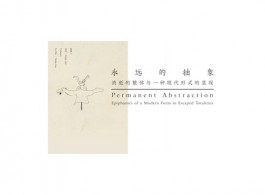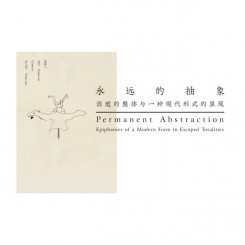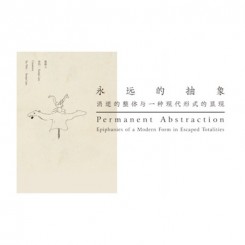Curators: Su Wei, Sonja Lau
Artists: Ding Yi, Eugen Popa, Li Jin, Liu Ding, K.M. Максимов, Ni Haifeng, Pang Xunqin, Triplicate Studio (Sui Jianguo, Zhan Wang and Yu Fan), Shi Zhenyu, Tang Jixiang and Yu Guohong, Wu Dayu, Wu Yinxian, Xie Nanxing, Yan Lei, Zhang Wei, Zhuang Yan
Hosted by: Red Brick Art Museum
Dates: 6 November 2016 to 19 February 2017
Opening: 16:00, Sunday 6 November 2016
Address: Red Brick Art Museum, Shunbai Road, Chaoyang District, Beijing
On November 6, 2016, Permanent Abstraction: Epiphanies of a Modern Form in Escaped Totalities will open at the Red Brick Art Museum in Beijing. The exhibition is curated by Su Wei and Sonja Lau.
We can see in “abstract” painting the imagination of the nation and the state and also private sensibilities, but despite this “abstract” painters are marginalized and sadly often not given a historical position. However, this might only be the case if we perceive “abstract” painting from a modernist aesthetic perspective. From the 1930s onwards, revolutionary ideology and from the 1950s onwards, the aesthetic ideology of mandatory realism, constructed a narrative that dominated Chinese culture. “Abstract” art was like a “present absentee” in these two societally and government-guided ideologies; “abstract” art experienced Chinese political and cultural history along with the rest of art, but it did not seem to exercise its political power or ability to construct history, its intrinsic perceptual power and long-standing inability to openly present its aesthetic sensibility meant it failed to claim its historical position. What we perceive as “abstraction” was repressed, broken, and without historical foundation; it existed in the shadows, scattered to all corners of history, so an aesthetic imagery form became an “abstract” structure.
Today in the Chinese contemporary art world, with a lack of this historical and contextual linkage, “abstract” art is currently flourishing as both imagery and form. “Abstraction” received political affirmation precisely because it made no outwardly apparent references. In the meantime, we can all sense that the political value system carries a dose of nihilism, and that economic value is all that is allowed to be expressed. This veneration of the economic has permeated the still inseparable cultural and political worlds. If we foster a cognitive dialogue with a Suprematist painting, these values suit the completely “abstract” structure: economics, as the only set of foundational principles allowed, are omnipresent, and thus the final site for values are a reference to a sense of lost time and space. To a large extent, the self-referential political/economic vacuum, dictates the space for artistic creation.
Based on this focus on “abstract” structures, we might boldly infer that the history of “abstract” art as a canon does not give a full account of the history of the genre. This history compels us to look back and discover a new historical conclusion and interpretive space. “Permanent Abstraction” refers to a historical story that has not yet disappeared. “Abstract” methods move between the political and artistic realms, which are parasites of one another and move in ways that suit one another. Due to the differences in historical experience and aesthetic ideas brought about by spatial and temporal dislocation, Chinese aesthetic traditions and modernist transplantations did not emerge as the primary threads of this exhibition. We tended to intensify the disappearance of a totality that was absolute, which blurred the temporal and spatial transformations of history and coexisted with both the past and the present. “Permanent Abstraction” parodies a complex “eternal” attitude to time, drawing also on its absoluteness and authoritarianism. It is the “abstract”, this modern identification of the everlasting but ever changing, a historical space-time transformation, but at the same time, it is also a kind of self-affirmation and self-mockery. On the basis of the interpretation of the metaphors of the images, the exhibition will use two narrative threads, “continuation” and “repetition”, to stimulate the transformation, penetration and diversification of this artistic trope, as well as the unattainable desire that the authoritative and dominant narrative cannot illustrate.
The exhibition runs through February 19, 2017.
Curater: Su Wei
Su Wei (born in Beijing, 1982) is an independent art critic and curator based in Beijing and Hong Kong. He participated in the 2012 Curatorial Intensive at Independent Curators International (ICI) in New York. In 2014, he was awarded first place at the first International Awards for Art Criticism (IAAC).
In 2012, Su Wei co-curated the 7th Shenzhen Sculpture Biennale Accidental Message: Art is Not a System, Not a World, OCT Contemporary Art Terminal (OCAT), Shenzhen. In 2014, he curated Keep the Modern Going: Immersion, Awaiting and Idealism, at OCAT, Shenzhen. In 2015, he participated in the symposium Dislocations: Remapping Art Histories at Tate Modern, London. In 2016, he curated No References. A Revisit of Hong Kong Media and Video Art from 1985 at Videotage, Hong Kong.
He has published a number of articles in local and international art journals including YISHU: Journal of Contemporary Chinese Art and Kunstforum. His publications include Individual Experience: Conversations and Narratives of Chinese Contemporary Art from 1989-2013 (with others), Ling Nan Art Publishing House, 2013; Hans Belting, Art History after Modernism, translated from German to Chinese by Su Wei, with additional annotations by Carol Yinghua Lu and Su Wei, Beepub Publishing House, Jan. 2014.
Curater: Sonja Lau
Sonja Lau is an independent curator and cultural producer based in Berlin. Upon completing her Curatorial Masters at the Chelsea College of Art and Design, London, she was awarded a two-year Fellowship for Cultural Innovation and most recently worked as a Robert Bosch fellow, with a focus on Tirana and South Eastern Europe and “art after the end of the grand narratives”. She has curated shows at various art institutes, including the KW Institute for Contemporary Art and the German Hygiene Museum (DHMD), in Dresden.
In the course of the last few years her work has focused on alternative art histories, as in, “Ri-Pikturim / Re-Paintings” (National Gallery of Tirana, 2008), a show that offered a revision of Socialist Realism, and “TRY… AGAIN… BETTER. Cornelius Cardew / Korneljus Kardju” in Tirana (National Historical Museum, 2012), a symphonic concert and “political listening experience”. From 2013 to 2014, she held a research position at the Jan Van Eyck Academy in Maastricht. She was the curator-in-residence at Schloss Ringenberg in 2015, for which she developed the performance piece “Zusammenhang Gesamtkunstwekr” (based on Harald Szeemann’s Der Hang zum Gesamtkunstwerk) at Kunsthalle Düsseldorf.



